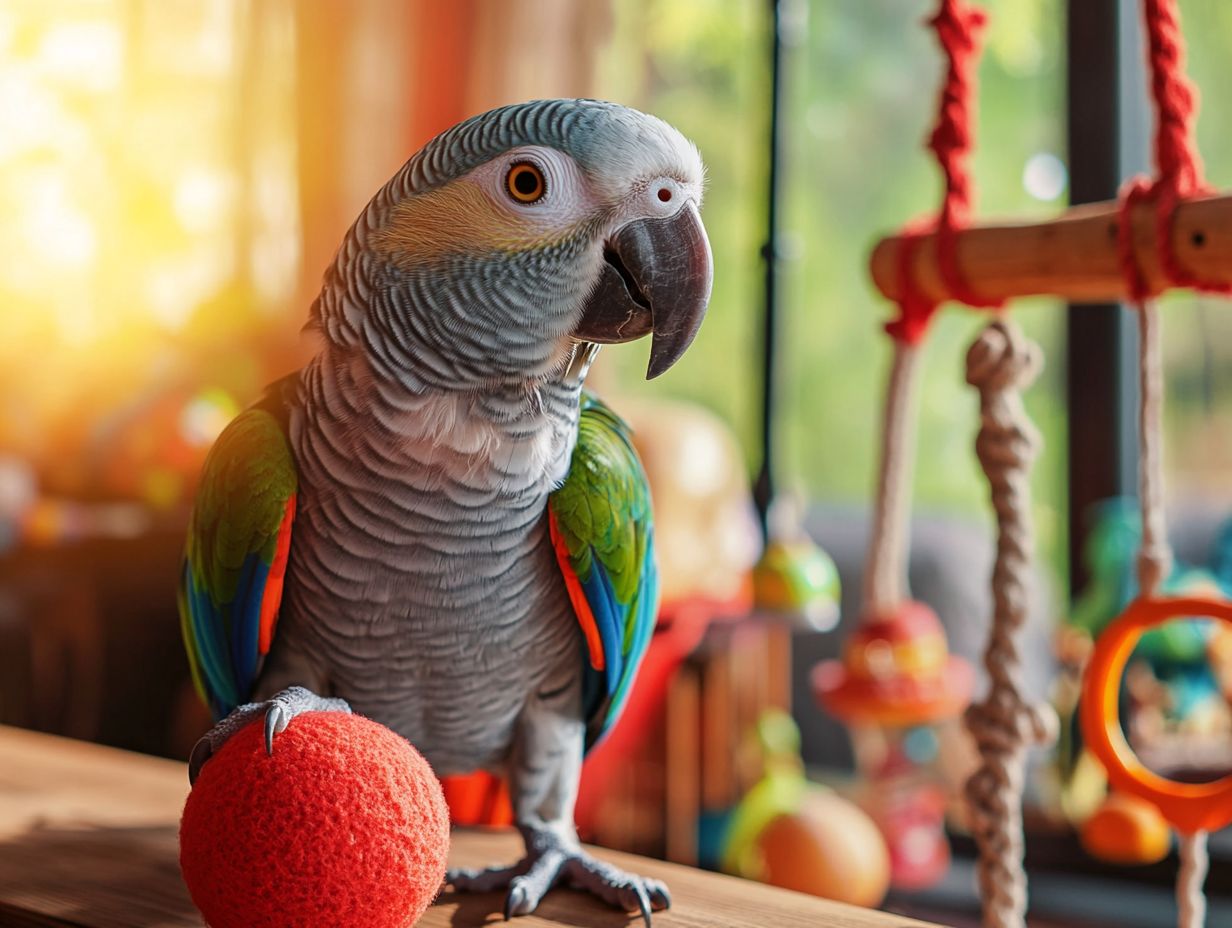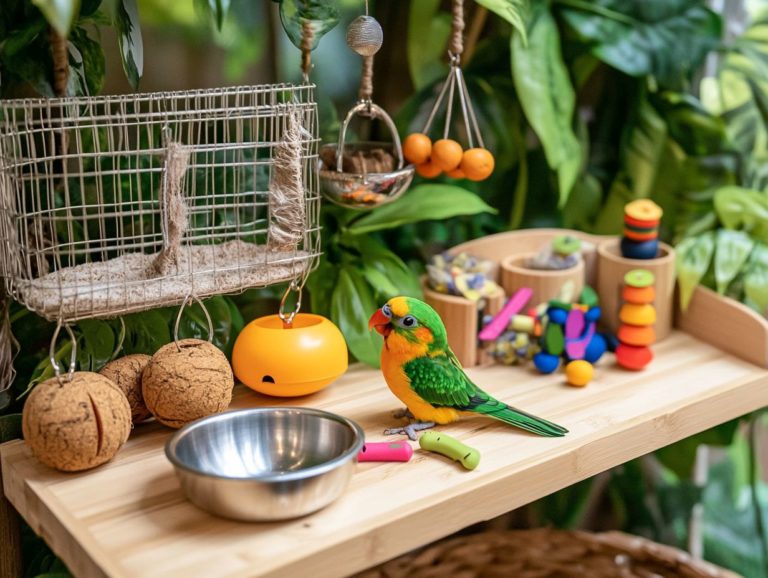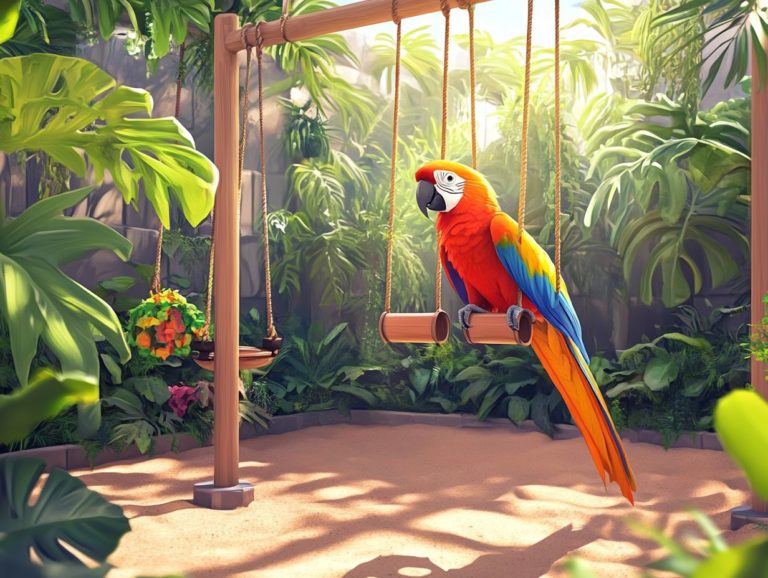Understanding Your Bird’s Play Style and Toys
Birds are vibrant, intelligent companions. Grasping their distinct play styles can significantly elevate their well-being and happiness, especially when considering their toy preferences and needs.
This article delves into the diverse types of bird play styles and guides you in selecting the perfect bird toys. It also presents some imaginative DIY toy ideas.
It also presents important care tips for maintaining your bird’s toys and underscores common safety considerations to avoid in your selections.
Get ready to transform your feathered friend s life with exciting playtime activities!
Contents
- Key Takeaways:
- Understanding Your Bird’s Play Style
- Choosing the Right Toys for Your Bird
- Making Your Own Bird Toys
- Caring for Your Bird’s Toys
- Common Mistakes When Choosing Bird Toys
- Frequently Asked Questions
- What is a bird’s play style?
- How can I determine my bird’s play style?
- Why is it important to understand my bird’s play style, including their toy types and preferences?
- What types of toys are suitable for my bird’s play style?
- How often should I rotate my bird’s toys?
- What should I do if my bird shows no interest in toys?
Key Takeaways:

- Understand your bird’s play style to provide appropriate toys for their physical and mental stimulation.
- Consider size, materials, and interactive features, along with safety, when choosing toys for your bird.
- Get creative and save money by making your own bird toys using household items and safe materials.
Understanding Your Bird’s Play Style
Understanding your bird s play style is essential for offering the right toys and activities tailored to their unique needs, including species-specific preferences. Birds, particularly parrots and cockatoos, display a variety of play styles that mirror their natural instincts.
By carefully observing how they engage with toys and their surroundings, you can uncover their preferences, such as foraging toys toys that encourage natural searching behavior for food and chew toys. Acknowledging these play styles not only stimulates cognitive development but also helps mitigate behavioral issues like feather plucking, ultimately enhancing your bird s happiness and health.
Types of Bird Play Styles
Birds showcase a delightful range of play styles, including interactive play, climbing, and comfort-seeking behaviors. Each style demands specific types of toys, like climbing toys and chewable materials, for maximum engagement.
By understanding these play styles, you can select the most appropriate toys that promote your bird’s healthy development and overall well-being. Engaging options encourage exploration. For example, interactive toys like puzzles and foraging devices stimulate cognitive skills and encourage problem-solving and exploration.
Climbing toys, such as ladders and ropes, cater to physically active birds, boosting their agility and strength. On the other hand, comfort toys think soft plush items or soothing chews offer emotional support, helping alleviate stress and anxiety while addressing specific behavioral issues.
By choosing a diverse array of toys tailored to these play styles, you can create a stimulating environment that fosters happiness and enrichment for your feathered companions.
Choosing the Right Toys for Your Bird
Selecting the ideal toys for your bird is crucial for maintaining its mental stimulation and promoting physical activity, particularly through individualized play. When making your choice, consider various factors, including safety and the individual preferences of your bird, particularly their favorite toy types.
Factors to Consider

When selecting toys for your bird, think about these important factors: safety, the importance of toy rotation, and encouraging natural behaviors with engaging options like interactive toys.
Safety is paramount. Harmful materials can pose serious risks to your feathered friend. Choose bird-safe materials for non-toxic, durable toys that are free from small parts, ensuring toy safety.
Regularly rotating toys keeps your bird engaged and prevents boredom, which can lead to destructive behavior.
Opt for stimulating choices like puzzle toys, foraging toys (toys that encourage birds to find food), and climbing toys. These options provide entertainment and tap into your bird s natural instincts while encouraging exploration and play.
Incorporating a variety of textures, such as wooden blocks and other natural materials, as well as different shapes, can captivate their attention, ensuring they remain mentally and physically enriched.
Types of Toys for Different Play Styles
Different play styles require specific types of toys to meet your bird’s unique needs and preferences, whether they prefer foraging toys, climbing structures, or chew toys.
Foraging toys are exceptional for mental stimulation. They entice your feathered friend to search for hidden treats, promoting overall well-being. These toys challenge their intellect and ward off boredom.
Chewable materials are crucial for maintaining beak health and preventing destructive behaviors. They provide a satisfying outlet for your bird to wear down their beak while enjoying safe and enjoyable textures, especially with natural materials like wood and coconut shells.
Climbing toys are important for encouraging physical activity. They allow your avian companion to exercise their muscles and explore their environment, ultimately fostering a happy and balanced lifestyle.
Making Your Own Bird Toys
Crafting your own bird toys can be a delightful and fulfilling experience. You get to select bird-safe materials and tailor the designs to meet your bird’s unique preferences and parrot needs.
DIY Toy Ideas
Explore many DIY toy ideas using simple, bird-safe materials that foster sensory experiences and encourage interactive play.
Engaging in these projects not only entertains but also enhances your feathered friend s mental stimulation and physical activity. For instance, consider crafting chew toys from natural wood or pineapple leaves, incorporating textures that will spark your bird’s curiosity.
Another exciting option is to create interactive puzzles using cardboard tubes filled with hidden treats. This encourages foraging behavior and stimulates their cognitive skills. You might also use dried fruits and safe herbs to make hanging toys, promoting beak exercise while tantalizing their sense of smell.
These homemade creations significantly contribute to your bird s cognitive development, paving the way for a happier and healthier life.
Caring for Your Bird’s Toys

Caring for your bird’s toys is essential for ensuring their safety and enhancing your bird’s health and happiness during playtime. This includes engaging activities and observation techniques.
By paying attention to the condition of those toys, you create a safe and engaging environment that fosters joyful exploration and play, leading to behavioral enrichment.
Start rotating your bird s toys today for a happier pet!
Cleaning and Replacing Your Bird’s Toys
Cleaning and replacing your bird’s toys should be a regular part of your routine. This ensures both safety and fun activities for your feathered friend, maintaining their mental stimulation.
Maintaining a clean and stimulating environment is vital for their well-being. Start by examining each toy for signs of wear, like frayed edges or loose parts, indicating that it s time for a replacement.
Use safe cleaning solutions like vinegar diluted in water to effectively remove debris and bacteria. This contributes to toy safety.
For wooden toys, a gentle scrub with a mild soap solution followed by a thorough rinse can do wonders for maintaining their safety and longevity.
Always keep an eye out for excessive chewing or damage that could create a choking hazard. Promptly replacing any compromised toys is essential to ensure safety and prevent behavioral issues.
Staying on top of this routine not only extends the life of the toys but also fosters a healthy play environment for your avian companion.
Common Mistakes When Choosing Bird Toys
As a bird owner, you might fall into common traps when selecting toys for your feathered friend. These missteps can pose safety hazards and lead to behavioral problems, including destructive habits like feather destruction.
Choose safe materials to keep your pet happy and healthy. Making informed choices is crucial for ensuring your pet’s well-being.
What to Avoid
When selecting toys for your bird, it’s crucial to steer clear of harmful materials and unsuitable options. These could lead to significant safety concerns or behavioral issues, such as feather plucking.
Certain materials, like BPA-containing plastics, a chemical found in some plastics that can be harmful, can be toxic if ingested. Additionally, untreated wood may splinter, posing choking hazards, making it essential to choose safe wooden toys.
Avoid metal toys that could harm your bird! Toys that contain lead or zinc can be harmful if chewed.
Choosing natural fiber toys over synthetic ones is a wise choice. Synthetic toys can easily entangle a bird s feet or beak, leading to potential behavioral issues.
Overlooking these safety considerations can result in physical harm and stress-induced behaviors, like feather plucking or aggression. These issues ultimately affect your bird’s happiness and health.
By ensuring the environment is both stimulating and secure with diverse play options, you contribute significantly to your bird’s overall well-being and happiness.
Frequently Asked Questions

What is a bird’s play style?
A bird’s play style refers to how they interact with toys and engage in play. This is influenced by factors like their natural instincts and preferences.
Some birds may prefer active and energetic play, while others may enjoy more passive and relaxed play.
How can I determine my bird’s play style?
Observe how your bird interacts with different toys and pay attention to their body language. If they are flapping their wings and vocalizing, they may enjoy more active play with engaging toys.
If they are calmly manipulating toys with their beak, they may prefer a more passive play style, possibly opting for comfort toys or chew toys.
Why is it important to understand my bird’s play style, including their toy types and preferences?
Understanding your bird’s play style helps you provide appropriate toys and activities they will enjoy. This knowledge can also keep them mentally and physically stimulated, promoting good health and preventing boredom, as outlined in understanding the role of play in bird health.
What types of toys are suitable for my bird’s play style?
For birds with an active play style, toys that encourage movement, such as swings or ladders, are ideal. For birds with a more passive play style, consider toys that require problem-solving, like puzzle toys.
How often should I rotate my bird’s toys?
Rotate your bird’s toys every 1-2 weeks. This prevents them from becoming bored with the same toys and keeps their playtime interesting.
What should I do if my bird shows no interest in toys?
Is your bird ignoring its toys? Don’t worry! Try different toys to see what captures their interest.
You can also play with the toys yourself to show your bird how to engage with them. If your bird still doesn’t respond, see an avian vet for advice. Act fast to keep your feathered friend happy!






